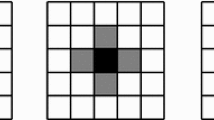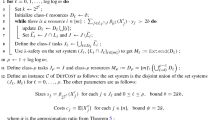Abstract
In the Maximum Scatter Traveling Salesman Problem the objective is to find a tour that maximizes the shortest distance between any two consecutive nodes. This model can be applied to manufacturing processes, particularly laser melting processes. We extend an algorithm by Arkin et al. that yields optimal solutions for nodes on a line to a regular (\(m \times n\))-grid. The new algorithm \(\textsc {Weave}(m,n)\) takes linear time to compute an optimal tour in some cases. It is asymptotically optimal and a (\(\frac{\sqrt{10}}{5}\))-approximation for the (\(3\times 4\))-grid, which is the worst case.
I. Hoffmann Partially supported by a grant of the Oberfrankenstiftung, project number: 03549.
Similar content being viewed by others
References
Arkin, E., Chiang, Y.-J., Mitchell, J.S.B., Skiena, S.S., Yang, T.-C.: On the maximum scatter TSP. SIAM J. Comput. 29, 515–544 (1999)
Chiang, Y.-J.: New approximation results for the maximum scatter TSP. Algorithmica 41, 309–341 (2005)
Author information
Authors and Affiliations
Corresponding author
Editor information
Editors and Affiliations
Rights and permissions
Copyright information
© 2017 Springer International Publishing Switzerland
About this paper
Cite this paper
Hoffmann, I., Kurz, S., Rambau, J. (2017). The Maximum Scatter TSP on a Regular Grid. In: Dörner, K., Ljubic, I., Pflug, G., Tragler, G. (eds) Operations Research Proceedings 2015. Operations Research Proceedings. Springer, Cham. https://doi.org/10.1007/978-3-319-42902-1_9
Download citation
DOI: https://doi.org/10.1007/978-3-319-42902-1_9
Published:
Publisher Name: Springer, Cham
Print ISBN: 978-3-319-42901-4
Online ISBN: 978-3-319-42902-1
eBook Packages: Business and ManagementBusiness and Management (R0)




